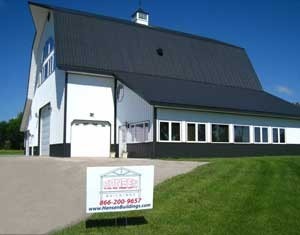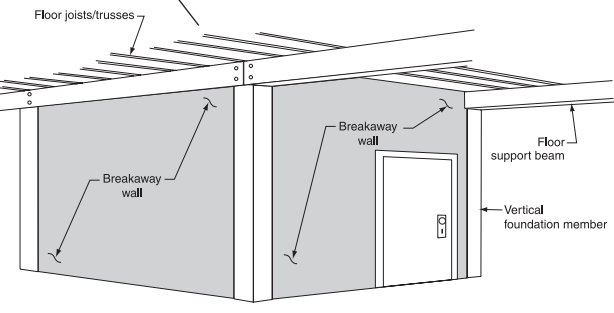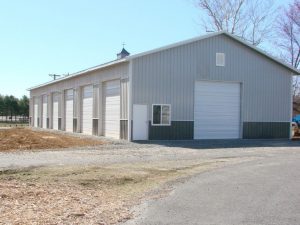This Friday’s daily blog will feature three questions and answers from the Pole Barn Guru. First is a question about financing, followed by a question about a vapor barrier for an add-on lean-to, and then building a quite lengthy boat storage facility.
DEAR POLE BARN GURU: Hi there. I’m looking to utilize a VA loan for 10 acres of property in West Texas. However, as a requirement, there must be a livable structure built with electrical and AC.
 It was always our intention to build a pole barn or barndominium on the property but with the requirement of having such in place to qualify, we now need to consider doing this as part of the loan process.
It was always our intention to build a pole barn or barndominium on the property but with the requirement of having such in place to qualify, we now need to consider doing this as part of the loan process.
So, my question really is, do people typically DIY with these barn kits or do they hire to build? I believe we’ll have to hire to build but I’m not sure who to contact or what is decent pricing for a build outside of the kit. I’m making a basic assumption of a 40 x 40 kit with 12 – 15 tall ceilings and basic foundation. We would convert it as a living space with insulation and electric as well during the process. We do intend on also building two separate living areas along with it in the future and then using the larger area for Entertainment.
Any guidance would be extremely helpful. Thank you! CORY in HURST
DEAR CORY: Obviously you are finding some challenges when it comes to being able to utilize your VA benefits: https://www.hansenpolebuildings.com/2020/08/va-loans-for-a-pole-barn-residence/
I would say our barndominium clients are pretty much evenly split between those who erect their own shells and those who hire it done. In order to get your best possible appraisal value to cash outlay – DIYing as much as possible will be to your advantage. A fair price to erect your shell is usually about 50% of what your investment is into your building kit.
 DEAR POLE BARN GURU: We are adding a 30×60 lean to shop area to out existing 40×60 insulated pole barn. I have been told a hundred different ways to insulate it, but my biggest concern for tomorrow is I have to make a decision. I pre built all of the walls and they are ready to go up. I am getting so much conflicting advice. We are connecting to the pole barn. (Yes it has been engineered)! Do I need to put a vapor barrier, vapor retardant, or any material against the existing outside wall that will become an inside wall? I have a crew coming over to help carry the walls and stand them up. I do have a couple of other questions, but this is the most pressing.
DEAR POLE BARN GURU: We are adding a 30×60 lean to shop area to out existing 40×60 insulated pole barn. I have been told a hundred different ways to insulate it, but my biggest concern for tomorrow is I have to make a decision. I pre built all of the walls and they are ready to go up. I am getting so much conflicting advice. We are connecting to the pole barn. (Yes it has been engineered)! Do I need to put a vapor barrier, vapor retardant, or any material against the existing outside wall that will become an inside wall? I have a crew coming over to help carry the walls and stand them up. I do have a couple of other questions, but this is the most pressing.
So my husband is really sleeping as I type this. It is midnight. He works late and has to get up early and I am up trying to research for him. When I read your story about you and your wife it reminded me of my husband and myself. We have worked on a lot of projects together.
Thank you in advance. JOLENE in WICHITA
DEAR JOLEEN: Kudos to you for having an engineered building! Just so much more prudent than not.
If your lean to and existing pole building are both conditioned then your inside wall needs no vapor barrier or retarder. Your new outside walls will need something however what it is will depend upon how you plan upon insulating.
 DEAR POLE BARN GURU: I’m looking to put in a boat storage facility, it will be 30′ wide by 600′ long and 15′ tall. What do I need to look at? GREG in PERRY
DEAR POLE BARN GURU: I’m looking to put in a boat storage facility, it will be 30′ wide by 600′ long and 15′ tall. What do I need to look at? GREG in PERRY
DEAR GREG: Column spacing will depend upon whether you are stacking boats (https://www.hansenpolebuildings.com/2018/09/boat-storage-pole-barns/) or placing them individually in bays. For 600′ in length, you will need to have interior shearwalls running 30′ direction probably no less than every 120 feet along your length. One of our Building Designers will be reaching out to you Monday to further discuss your needs and best design.

 What is your policy on transferring ownership of plans? DAN in NORTH BEND
What is your policy on transferring ownership of plans? DAN in NORTH BEND Once the first building was filled, we could have monitored requests for other unit sizes. By gradual growth, fill one, then build another, a hundred units probably would have been filled in a year, rather than just half. Being fairly close to the south end of Lake Pend Oreille, we could have expanded to 10’ x 25’ units, which will accommodate most pleasure boats, and then grown to units for larger boats and recreational vehicles.
Once the first building was filled, we could have monitored requests for other unit sizes. By gradual growth, fill one, then build another, a hundred units probably would have been filled in a year, rather than just half. Being fairly close to the south end of Lake Pend Oreille, we could have expanded to 10’ x 25’ units, which will accommodate most pleasure boats, and then grown to units for larger boats and recreational vehicles.





